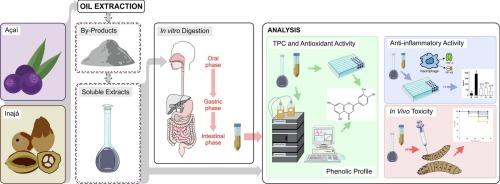体外胃肠道消化如何影响阿萨伊(Euterpe oleracea)和inajá(Maximiliana maripa)副产品的生物活性和酚类成分?
IF 9.8
1区 农林科学
Q1 CHEMISTRY, APPLIED
引用次数: 0
摘要
研究了açaí (Euterpe oleracea)和inajana maripa (Maximiliana maripa)果渣提取物的生物活性潜力和急性毒性。açaí果渣的生物可及部分(肠部分,IF)含有原儿茶酸、阿魏酸和香草酸,而inaj本文章由计算机程序翻译,如有差异,请以英文原文为准。


How does in vitro gastrointestinal digestion affect the biological activities and phenolic profile of açaí (Euterpe oleracea) and inajá (Maximiliana maripa) by-products?
This study investigates the bioactive potential and acute toxicity of açaí (Euterpe oleracea) and inajá (Maximiliana maripa) pomace extracts. The bioaccessible fraction (intestinal fraction, IF) of açaí pomace contained protocatechuic, ferulic, and vanillic acids, while inajá pomace had caffeic acid, glabridin, and an eriodictyol derivative. Both extracts showed similar total phenolic content and peroxyl radical scavenging capacity, with hypochlorous acid scavenging activity. Açaí pomace inhibited nuclear factor-κB (NF-κB) activation (85 % to 50 %) compared to inajá (33 % to 98 %), and both extracts reduced tumor necrosis factor-α (TNF-α) levels by over 81 % at 100 μg/mL, indicating anti-inflammatory properties. Acute toxicity tests in Galleria mellonella larvae showed no harmful effects at concentrations effective for antioxidant and anti-inflammatory activity. These findings suggest that açaí and inajá pomaces are promising natural sources of phenolic compounds for use in pharmaceuticals, cosmetics, and food industries.
求助全文
通过发布文献求助,成功后即可免费获取论文全文。
去求助
来源期刊

Food Chemistry
工程技术-食品科技
CiteScore
16.30
自引率
10.20%
发文量
3130
审稿时长
122 days
期刊介绍:
Food Chemistry publishes original research papers dealing with the advancement of the chemistry and biochemistry of foods or the analytical methods/ approach used. All papers should focus on the novelty of the research carried out.
 求助内容:
求助内容: 应助结果提醒方式:
应助结果提醒方式:


